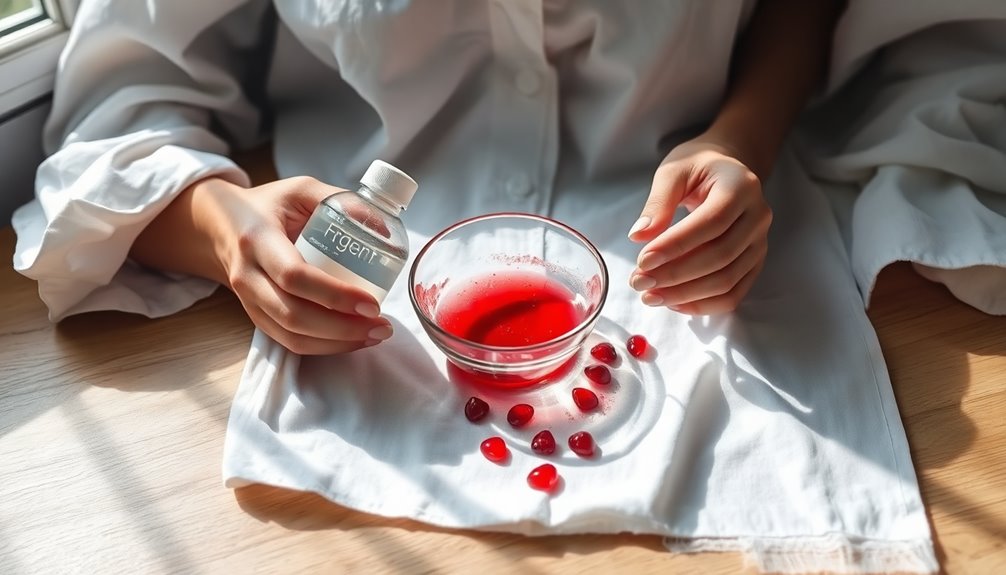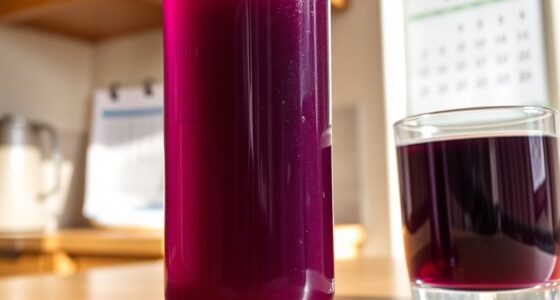To get strawberry juice out of clothes, act fast! Start by blotting the stain gently with a clean cloth to absorb excess juice. Rinse the fabric under cold water, holding it inside-out. Soak the garment in a mixture of 1 part white vinegar to 3 parts cool water for about 15 minutes. If the stain lingers, apply rubbing alcohol, then wash the garment in hot water per its care instructions. Stick around to uncover more tips!
Key Takeaways
- Act quickly by blotting the stain with a clean cloth to absorb excess strawberry juice without rubbing.
- Rinse the stained area under cold water, holding the fabric inside-out to flush out the juice effectively.
- Soak the garment in a solution of 1 part white vinegar to 3 parts cool water for about 15 minutes.
- If the stain persists, apply rubbing alcohol directly to the area and let it sit for a few minutes before rinsing.
- Wash the garment in the hottest water safe for the fabric, adding 1/4 cup of vinegar for enhanced stain removal.

When you accidentally spill strawberry juice on your clothes, don't panic; you can tackle the stain effectively. The key is to act quickly before the juice sets into the fabric. First, grab a clean cloth or paper towel and start blotting the stain gently. Blotting helps absorb excess liquid without pushing the juice deeper into the fibers. The goal is to lift as much of the strawberry juice as possible right away.
After you've blotted the area, it's time to rinse the stained part of your garment under cold water. Hold the fabric inside-out, letting the cold water flush out the juice from the fibers. This step is crucial because it helps prevent the stain from embedding itself further into the fabric. Make sure you rinse thoroughly, as any leftover juice can lead to a more stubborn stain later on.
Next, soak your garment in a solution of one part white vinegar to three parts cool water. Let it soak for about 15 minutes to allow the vinegar to break down the strawberry stains. White vinegar is a natural stain-fighting agent, and it can work wonders on fruit juices. After soaking, gently rub the stained area to help lift the stain further, but be careful not to damage the fabric.
If the stain persists, you can apply rubbing alcohol directly to it. Use a cloth or cotton ball to dab the alcohol onto the stain, but before you do, test it on an inconspicuous area first. This step ensures that the alcohol won't harm or discolor your garment. Once you confirm it's safe, apply the rubbing alcohol and let it sit for a few minutes.
Now it's time to wash the garment. Use the hottest water that's safe for the fabric, along with your regular detergent. Adding 1/4 cup of vinegar to your wash will enhance stain removal, giving you an extra boost against those pesky strawberry stains. Make sure to follow the care label on your garment to avoid any damage during washing.
After washing, check the stained area before you toss the garment into the dryer. It's crucial to avoid drying the fabric until the stain is completely gone, as heat can set the stain and make it nearly impossible to remove. If the stain is still visible, you can repeat the soaking or washing process. Sometimes, it takes a couple of tries, but don't lose hope! With these methods, you can effectively remove the stain and save your favorite piece of clothing from becoming a casualty of your snack.
Frequently Asked Questions
Do Strawberry Juice Stains Come Out?
Yes, strawberry juice stains can come out if you act quickly.
When you notice the stain, rinse the fabric under cold water immediately to flush out the juice. Soaking it in a vinegar solution can help lift the stain further.
If needed, you can apply rubbing alcohol directly to the stain, but test it first on a hidden area.
Finally, wash the garment in hot water and check that the stain is completely gone before drying.
How to Remove Strawberry Stains From Clothes?
To remove strawberry stains from clothes, act quickly!
Start by blotting the stain with a clean cloth and rinsing it under cool water.
Next, soak the fabric in a mixture of cool water and vinegar for about 15 minutes.
After that, dab some rubbing alcohol on the stain, testing it first on an inconspicuous area.
Finally, wash the garment in hot water with detergent and vinegar, checking for the stain before drying.
Is Hot or Cold Water Better for Strawberry Stains?
When dealing with strawberry stains, cold water's your best friend. It rinses away the juice effectively, preventing the pigments from setting into the fabric.
If you use hot water, you risk making the stain worse by bonding the sugars to the fibers. Rinse the stain immediately with cold water, and consider soaking the fabric in a cool water and vinegar solution for better results.
How to Get Berry Juice Out of Clothes?
When life gives you berry stains, don't let them linger.
First, you'll want to blot the stain with a clean cloth to soak up as much juice as possible. Rinse it under cool water, then soak the item in a vinegar solution for 15 minutes.
Dab with rubbing alcohol next, and wash in hot water with detergent and a splash of vinegar.
If the stain's still there, repeat the process until it's gone!
Conclusion
Now that you know how to tackle strawberry juice stains, don't let those delicious treats ruin your favorite clothes! Remember, 1 in 5 people have faced a fruit stain mishap at some point, so you're not alone. With quick action and the right techniques, you can save your wardrobe from pesky stains. Next time you enjoy strawberries, keep these tips in mind, and you'll be ready to handle any spill like a pro!
Cindy thoroughly researches juicing trends, techniques, and recipes to provide readers with practical advice and inspiration. Her writing style is accessible, engaging, and designed to make complex concepts easy to understand. Cindy’s dedication to promoting the advantages of juicing shines through her work, empowering readers to make positive changes in their lives through the simple act of juicing.











